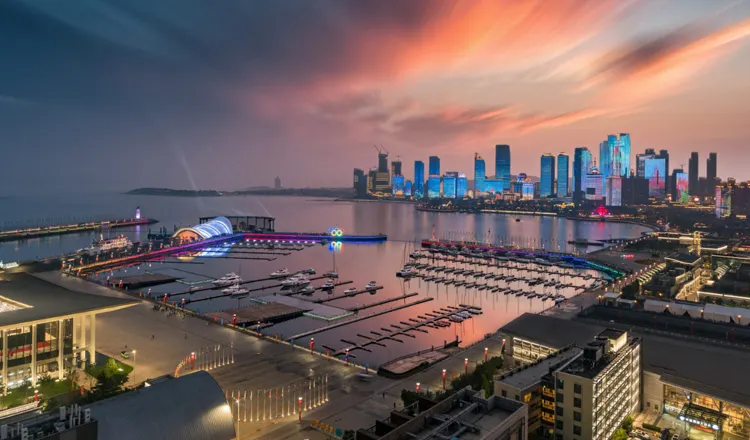
As Qingdao continues to attract tourists and international businesses from around the world, the abundance of natural beauty, talented human resources, three central business districts, and the new Blue Silicon Valley continue to lure foreign investment. Qingdao, known as China’s Sailing City, is a popular tourist destination during the spring, summer, and fall. The city has decent air quality that is most always better than that of Beijing or Shanghai.
Qingdao annually hosts the International Sailing Week (青岛国际帆船周), SINO CES (中国国际消费电子博览会), and International Beer Festival (青岛国际啤酒节). The Clipper Round The World Yacht Race is hosted bi-annually.
In 2008, Qingdao hosted the Sailing Regattas of the 29th Olympic Games as well as the 13th Paralympic Games at the Olympic Sailing Centre & International Marina. In 2009, China’s Sailing City welcomed sailors from the Volvo Ocean Race (VOR 2008-2009). In 2014, Qingdao hosted the International Horticultural Exposition (青岛世界园艺博览会) in Baiguo Mountain Park of Licang District.
Qingdao Historical Dates & Events
Throughout history Qingdao has had several names: Tsingtau, Tsingtao, Jiāo’ào, Jiaozhou, Kiaochow, Kiauchau, Kiautschou, Qindao.
Tsingtau was a German concession from 1897 to until the First World War broke out in 1914. During the Seige of Tsingtao the Japanese took control of the region while declaring war on Germany.
In 1919, the May 4th Movement was launched. Protesters against the Chinese government’s decision to yield to Japanese pressure demanded the recommencement of sovereignty over the region.
The city reverted to Chinese rule in 1922, but was occupied by Japan again in 1938 during WWII. During this time the Japanese had plans of territorial expansion into China’s coastal cities.
In 1945, after Japan’s defeat in WWII, Qingdao served as the headquarters of the Western Pacific Fleet of the US Navy.
On September 2, 1945, the U.S. Marines were ordered to participate in the occupation of certain areas of China primarily to assist Chiang Kai-shek’s government in the surrender and disarmament of Japanese troops. Allowed by the Kuomintang in October 1945, the USS Alaska occupied the city which at that time was called Tsingtao.
The 6th Marine Division, under the command of General Lemuel C. Shepherd (later Commandant of the Marine Corps), was ordered to carry out the mission in the Tsingtao-Chefoo area. The 6th Marine Division was deactivated on March 31, 1946 and the Tsingtao command was sized down to become a reinforced brigade. In May 1947, after more reductions in force, the command became Fleet Marine Force Western Pacific (“FMFWesPac”).
Some Marine units remained in Tsingtao until early May 1949. Tsingtao was the headquarters of the Western Pacific Fleet of the US Navy from 1945 to 1949. The Marines provided security for the naval facility in the northwest part of the city.
On June 2nd 1949, the People’s Liberation Army (PLA) entered the city. Shandong and local municipalities have been under the People’s Republic of China (PRC) control since that time.
Qingdao Tourism & Geography
Qingdao is well known for its European architecture, attractive coastal landscapes, and local folklore. Popular attractions include mystical Mount Lao, Badaguan, Tsingtao Brewery Museum, and Zhongshan Park. With its abundance of natural beauty, the year-round schedule of international events and seasonal tourist attractions make China’s Sailing City an ideal tourist destination for both domestic and international travelers.
Also known as the Switzerland of the east, Qingdao lies on the Shandong Peninsula in Jiaozhou Bay. It has eight urban districts (Shinan, Laoshan, Huangdao, Shibei, Licang, Hongdao, Jimo, and Jiaozhou) and jurisdiction over four county level cities (Jimo, Jiaozhou, Pingdu, Laixi). Facing the Yellow Sea, Qingdao occupies 10,645 square kilometers of land with a population of more than 8.7 million.
As of January 2019, Qingdao implemented a 144-hour (6-day) visa-free transit policy to facilitate business and tourism. Visitors can enjoy a 144 hour visa-free stay while taking an international transfer via Qingdao Jiaodong International Airport (青岛胶东国际机场) or sea port.
Qingdao Economy
As one of China’s most important independent coastal regions with state planning and budgeting powers, the city has experienced rapid growth over the last decade. Qingdao’s Port is the second-largest in China. It handles more imports of natural rubber, cotton and crude oil than any other port in the country.
The Qingdao Economic & Technological Development Zone (QETDZ), Sino-German High-Tech Ecology Park, and three Central Business Districts combine to form Shandong’s premier international business Mecca and Blue Silicon Valley. Qingdao’s major industries include trade, light industry, home appliances, petrochemicals, vehicles, textile processing, food processing, machinery, pharmaceuticals, tourism and oceanography research.
The coastal waters of Jiaonan, now part of Huangdao District ( Qingdao West Coast), are home to China’s first aircraft carrier Liaoning. The naval base, home to China’s North Sea Fleet, extends into the mountains behind the seaport and has extensive underground facilities that house a compliment of nuclear missiles and ammunition. In April 2014, US Defense Secretary Chuck Hagel toured the carrier Liaoning at the naval base during his first official visit to China.
Frequently Asked Questions About Qingdao
The Qingdao International Beer Festival, Tsingtao Beer, Olympic Sailing Center & Marina, European Architecture in Badaguan, Laoshan Mountain, Seaside Parks, and numerous bathing beaches.
Zhongshan Park, May 4th Square, St. Michael’s Cathedral, Qingdao Old Town, Bathing Beach #2, Golden Sands Beach, Badaguan (Eight Passes), Tsingtao Brewery Museum, Laoshan Scenic Area, Zhanqiao Pier, Qingdao International Sailing Center, Bathing Beach #1.